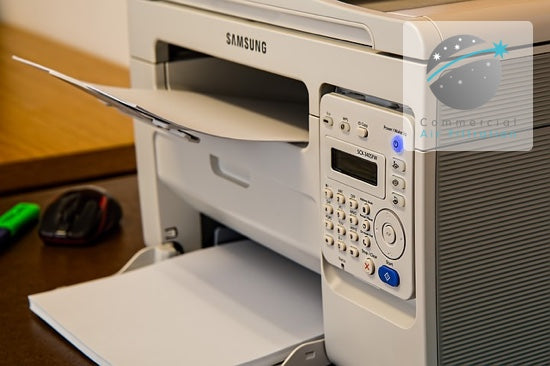We’ve heard quite a bit about particulate matter PM10s and PM2.5s as components of air pollution that we are exposed to on a daily basis. So I am wondering to what extent office printers emit pollution? Recent research papers are highlighting the dangers of ultrafine particles (UFPs), which have a diameter of less than 0.1 micrometers (or 100 nanometres). By contrast, the diameters of particulate pollution from PM10s and PM2.5s are 10 micrometers or less and 2.5 micrometers or less. This ultra-fine particle pollution is so small that it never settles on the ground, but hovers in the air indefinitely and is thus easily inhaled. Ultra-fine particle pollution is a concern because they are part of the nanoworld. Although there’s rightly a lot of excitement about the potential of nanotechnology and nanomedicine, there are also safety issues around just what happens when nanoparticles (like ultrafine particle pollution) penetrate the body. They are so small that they can penetrate far deeper into the lung than PM10s or PM2.5s and they can even get into your bloodstream. Once in your bloodstream, the particle pollution can reach every part of your body- from the heart to the brain. Because of this danger, the Environmental Protection Agency is funding several studies on the impact of ultrafine particle pollution on our health.
I’m sitting next to a laser printer as I write this, and it is clear that office printers emit pollution - but how bad it is? Most of us spend time either using or around, an office printer without being aware of the pollution it can create. A study from Canada that came out in 2007 showed that a significant number of office printers emit pollution, especially high amounts of ultrafine particulate pollution. The researchers said the impact was not dissimilar to sitting next to someone who is smoking.
There was another recent study, by Australian scientists, that measured ultrafine particulate pollution emissions of 62 printers. Forty percent did emit UFPs, some of them in very high concentrations. Office printers emit pollution and increased indoor particle counts fivefold during work hours. More particles were emitted when operating with new toner cartridges and when printing graphics and images, which need more toner and release a great range of print fumes.
Another study, published last year, measured particle emissions from three modern laser printers into a chamber simulating an office room. This confirmed that most of the particles emitted were URPs and, when the printers were in action, they increased the particle concentration in the ‘office’ to a level 11 times that of the background level. Another problem is, that even if you are not sitting right next to the printer, modern ventilation systems often distribute the particle pollution throughout the entire office without filtering it from the air.
But it’s not just printers that emit UFPs. Researchers in the United States reviewed other sources and say that exposure can occur from many sources such as cooking, driving, smoking, or operating a hair dryer. They spent three years measuring ultrafine particles with portable monitors in homes, cars, and restaurants. Cooking with gas and electricity was a major source of UFPs. Other sources included cigarettes (as you might expect), hair dryers, steam irons, and candles. The take-home message here, I think, is that indoor exposure to ultrafine particulate pollution is often much more significant than outdoor exposure. The researchers believe that 47% of your exposure to UFPs comes from indoor pollution, compared to just 36% from outdoors and 17% from being in a car. So, as we have said here before, do not underestimate the health impact of indoor pollution.
The positive note is that you have much more control over this kind of air pollution in your office than you do over outdoor pollution. Ventilation systems in offices can be equipped with high-efficiency particle filters for HVAC systems. Most office ventilation systems come with a filter, as I am sure your employer will be happy to point out - but don't be fooled. Those standard filters are there to protect the ventilation system engine from large dust particles, hairs, flies etc., they are not there to protect your health and they will not filter any fine or ultrafine particle pollution.
Small and medium-size offices are best equipped with stand alone, plug and play office air cleaning solutions. Larger rooms would require a unit such as the IQAir CleanZone SLS of high-performance air cleaners. But whatever your air pollution needs are, contact us anytime and we are happy to provide you with a free expert consultation. You can also set up an indoor air assessment, during which one of our experts measures the pollution levels in your home or place of work and helps you find the best solution for creating a healthy indoor environment. Call us on 0203 176 0524.
Sources:
He C et al. Particle emission characteristics of office printers Environmental Science and Technology August 1 2007;41:6039-6045
Koivisto A et al. Impact of particle emissions of new laser printers on modelled office room Atmospheric Environment June 2010;44:2140-2146
Wallace L and Ott W Personal exposure to ultrafine particles Journal of Exposure Science and Technology online 20th January 2010;21:20-30




